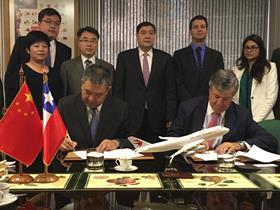
Asoex and China Eastern Airlines have signed a memorandum of understanding to advance exports of Chilean fruit to China, in particular cherries and blueberries.
The move, which seeks to strengthen collaboration in key areas like logistics and marketing, builds on a deal signed last season to promote Chilean cherries on flights between Shanghai and Beijing, one of the airline’s most popular routes.
China Eastern Airlines transports around 500,000 passengers a day, creating an ideal opportunity to promote Chilean fruit to them and to the Chinese population in general via the airline’s media presence.
The memorandum was signed during a visit by a delegation from the airline to Asoex’s offices in Santiago on Thursday.
“This is an important agreement that will allow us to reach the Chinese market quickly at the start of the season and complements similar activities we will be carrying out with other airlines,” said Asoex president Ronald Bown. “We are talking about a major airline, and the fact that its president has come to Chile to sign this deal reflects the opportunity that exists for mutual cooperation, not just in logistics but also other fields, to boost sales of our cherries in China.”
A key aspect of the strategy will be the exchange of information on the volume of weekly fruit shipments in order to optimise services and enable fruit to reach the market as quickly as possible.
Bown said another of the options being evaluated was to invite Chinese premier Xi Jinping to attend the inaugural airfreighted shipment of Chilean cherries via China Eastern Airlines when he visits Chile in November.
The president of China’s Easter Air Logistics, Li Jiupeng, who was also present at the signing ceremony, described Chilean cherries as a perfect match for China Eastern Airlines as both are built on quality and service. “We hope this agreement marks the start of a closer relationship with Asoex and will mean more high quality fruit arriving in China,” he said.
Steven Fang, vice president of Shanghai Eastern Airlines Express, said the airline was considering introducing more frequent flights to Chile and promoting Chilean fruit via its in-flight magazines.
“We are the sixth biggest airline in China, transporting half a million passengers a day nationally and internationally to whom we could be promoting Chilean fruit,” Fang said. “In particular this is an ideal opportunity to promote cherries, arrivals of which coincide with Chinese New Year.”
The deal will last for one year, after which it is subject to review.
During the meeting, Ignacio Caballero of Asoex revealed details of the association’s cherry marketing campaign for 2016/17, which includes advertising on television, social media, women’s magazines and metro stations as well as in-store tastings and point-of-sale promotions.
“Most of the US$5m campaign will be targeted at China but we’re also programming activities for the US, Brazil, Japan and South Korea,” Caballero said. “The aim is to position Chile as the main supplier of cherries to China, highlighting their rich taste, sweetness and quality.”
Cherry production was expected to bounce back in 2016/17 with early estimates pointing to a total crop around 23m 5kg cartons (equivalent to 115,000 tonnes) compared with last season’s 19m-carton total.
However Bown noted that heavy rains in central and southern regions in mid-October had affected blossoming in early varieties and would lead to losses that could be substantial. “In addition to the immediate physical damage that will prevent normal fruit development and sales, the rains will require the application of anti-rot treatments for all fruits, he said.






No comments yet